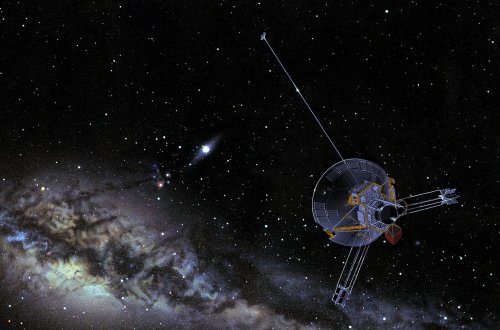
Artist’s impression of Pioneer 10 (Courtesy: NASA)
By Hamish Johnston
For more than a decade physicists have known that the space probes Pioneer 10 and Pioneer 11 are following trajectories that cannot be explained by conventional physics – leading some to speculate that this is the result of new and exciting physics.
Called the “Pioneer anomaly”, both spacecraft seem to be experiencing an extra tug towards the Sun as they move through the solar system. There has been much written about the origins of the extra acceleration, which is 10 billion times weaker than the Earth’s gravitational pull. Explanations have run the gamut from the gravitational attraction of dark matter, to modifications of Einstein’s general theory of relativity, to string theory and/or supersymmetry.
Now it seems that the answer could be much more mundane: heat generated onboard the spacecraft creates a thrust by escaping in an asymmetrical manner. That’s the conclusion of a paper to appear in Physical Review Letters and written by Slava Turyshev of the Jet Propulsion Laboratory in California and colleagues Viktor Toth, Jordan Ellis and Craig Markwardt.
The quartet’s painstaking analysis of telemetry data suggests that the anomalous acceleration of both spacecraft is decreasing with time. While the exact nature of this decrease is not certain, there is a good chance that it is exponential. This would be consistent with the decay of radioactive material with a half-life of about 27 years. Both spacecraft have radioactive power sources that are still running – so mystery solved.
Well, not quite. Both spacecraft are powered by plutonium-238, which has a half-life of about 88 years. However, the team believes that the more rapid drop in acceleration could be the result of degradation and changes to the thermal properties of the spacecraft over time. When these factors are considered, claim the researchers, a half-life of 27 years seems reasonable.
Studying the acceleration of Pioneer 10 and 11 has been a daunting task. Turyshev and others have sifted and processed decades-old data – and in some cases data have been found to be corrupt or missing. So it’s nice to see that the hard work is paying off, even if the answer is a bit dull.
Indeed, in 2004 Turyshev co-wrote an article for Physics World about the Pioneer anomaly that says “Dispassionately, the most likely cause of the anomalous acceleration of the Pioneer spacecraft is on-board systematics”.
A preprint of Turyshev’s latest paper is available here.



